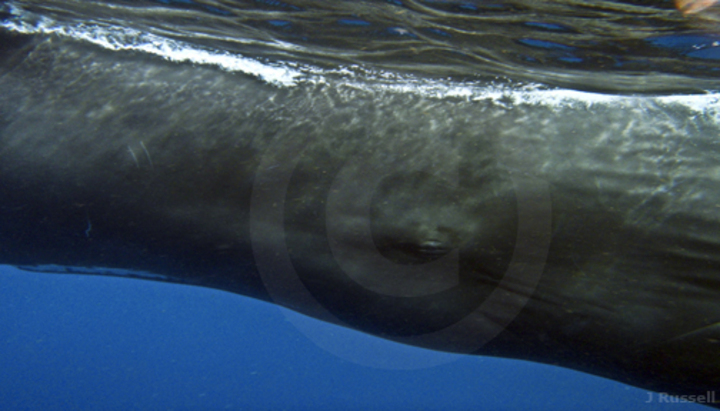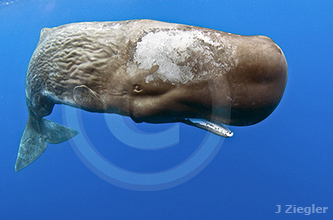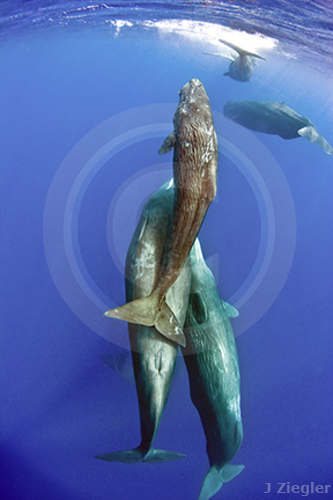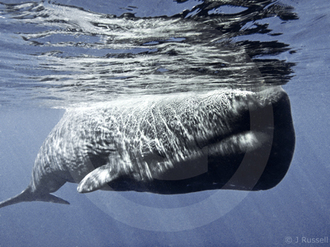::::: PHYSETER MACROCEPHALUS - COMMON CACHALOT :::::
: : : :Expedition Report: :On Our Fellow Mammal: :The Common Cachalot: : : :
An educational study of the largest toothed predator on Earth
The common cachalot, or sperm whale
by Jacqueline Russell
With the kind co-operation of the the Commonwealth of Dominica Fisheries Division
Images by Jakob Ziegler & Jacqueline Russell
BE AWARE: In most countries it is illegal to enter the water with marine mammals without advance government permission. We obtain a special department of fisheries research permit to carry out all of our studies. Researchers are specially trained, and have to adhere to strict guidelines, to protect the whales from stress. There is no physical interaction with the whales, no tagging or capture of any kind.
::::::::::::::::::::::::::::::::::::::::::::::::::::::::::::::::::::::::::::::::::::::::::::::::::::::::::
Cachalot have small paddle shaped pectoral fins, which contain five metatarsal bones, just like human hands.
COMMON CACHALOT Physeter macrocephalus, more commonly known as sperm whale, are on the IUCN list as vulnerable. Numbers are said to be down to only about 200,000 remaining in our oceans worldwide. The whalers of old named the common cachalot the 'spermaceti whale', or the 'sperm whale', for the spermaceti oil (a wax like oil) found in their heads. This oil was the main reason cachalot were still being killed in massive numbers up until as recently as the 1980's. 'Sperm whale' is a name that represents the killing of these intelligent beings. On this site they will be known by their traditional pre-whaling name, the 'common cachalot'.
The name cachalot means toothed whale, or big headed whale, which describes these whales perfectly. In the early 19th century there were said to be well over a million common cachalot in the worlds oceans, records show that over 200,000 were killed in the early 19th century. After WWII, with the huge advances in industry and the space race, the need for this rare and versatile oil grew, and a further 800,000 cachalot were slaughtered.
The dorsal fin is small and humped, the tail flukes are triangular, and the bottom jaw is narrow.
We know from past studies that the lifespan of a common cachalot is similar in years to a human. We know that the calving rate is one single calf about every 3-6 years, until about age 40, and the gestation period for pregnant females is 14-18 months. Calves nurse for 2-4 years, and a newborn weighs around 1 metric ton (2200lbs), and is about 4m long (13ft) at birth. Within a family, all females care for each other’s calves. Mothers dive deeply for food and leave their babies at the surface, because babies don’t dive that deep. While mothers are down other females babysit, in Dominica the babysitter tends to be the mother’s closest female relative.
A young whale will not begin 'fluking' (deep diving where the tail goes up) until around 3 years. Whales reach sexual maturity in their teens, but just like humans, males seem to mature later. Even though a male will reach sexual maturity by 18 years, he can continue growing in size until 50 years of age. Among cetaceans, common cachalot display the most difference in body size between males and females. Males reach up to 18 meters (65 feet) and weigh twice as much, up to 60 metric tonnes (125,000 lbs). As with most toothed whales only the young male cachalot leave their mothers, where as females stay with the female family unit for life.
A young male will leave it's mother for longer and longer periods, between 6 and 12 years of age. As they become more independent the young males form loose bachelor groups, and by the age of 30 males start to return and try to find females to mate with. Most adult males live solitary lives. They leave the areas of their birth, to find food in cooler oceans in the warm summer months. The larger the male, the closer to the polar regions they travel. As adult males are much larger than females they tend to feed in colder climates, because more food can be found. The males return to the warmer tropical, and sub tropical oceans, in the cooler winter months to socialize. Females, and young male common cachalot, tend to stay in warmer more tropical oceans year round.
A mother rests on the surface, in the rain, with a very young calf in the baby nursing position.
_330x220.jpg)
Cachalot help the planet by giving us clean air to breathe. By depositing iron rich feces into the ocean, it causes phytoplankton to grow and take up more carbon from the atmosphere. When the phytoplankton dies it sinks, taking the carbon with it. Studies have shown, that in the Southern oceans, excessive whaling has resulted in an extra two million tons of carbon remaining in the atmosphere each year. Whales are good for our planet, and we need more of them in our oceans, they help keep our planet running as it should. Whales balance the Earth.
Iron rich feces help give us clean air to breathe.
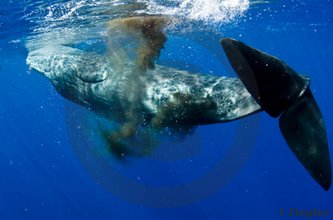
Common cachalot are intelligent thinking mammals. They have more sophisticated senses and natural communication systems than humans. Having echolocation as one of their senses means cachalot can emit wide angle beams of high frequency clicks, using the lower jaw to receive these sounds. The whales use bursts of sound, or sonar, to send and receive messages to each other in an advanced form of communication. These clicks, known by scientists as codas, are whale language and have a number of clicks in each sequence.
All common cachalot around the world, use the same language but with different accents. They all share the oceans of the Earth, so it makes sence to speak one language. But they have local accents and cultural differences.
Cachalot can use their amazing acoustic senses for socializing and communicating with each other, as a weapon to catch prey or as a tool to investigate objects. When we look into outer space to search for extra terrestrial life, it seems we may have overlooked the obvious, our oceans are filled with intelligent alien beings!
Floating above a socializing group, my place of worship...
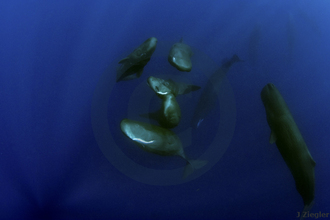
It's amazing to think that common cachalot may have the ability not just to see images, but to send and receive complicated messages to each other using their advanced sonar. They could have super hero like acoustic senses. We know they can send bursts of sounds lounder than any other living animal on Earth! We know they can see with sound as well as with their eyes. It's pretty incredible when you think about it, they use their super senses like we use wi-fi to communicate with each other.
"A whale scans me with it's sonar, as I float above"
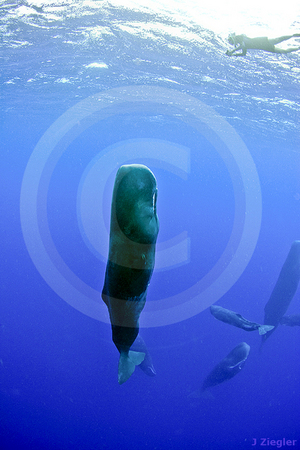
Toothed whales are extremely intelligent, just like us some individuals are more curious than others. When I have encountered a whale who is very curious of me, the results can only be described as an attempt at communication. Every cell in your body feels this is an intelligent being, looking back at you with as much awe and wonder as your own. They look into your eyes, they want to know more.
I've experienced a cachalot show me her fresh caught squid, with it still wriggling in her mouth. I've experienced cachalot come right up to my face, so close that I've backed up. I've had other toothed whales do the same thing to me with fish they just caught. I've been truely honoured to have baby cachalot come over to me and touch me, to see what I feel like. There have been several instances when young whales have clicked back as if in reply to clicks of camera shutters, mimicking the sounds exactly.
Toothed whales and dolphins are very curious of mechanical things, esspecially moving parts in video cameras. They can be curious of reflections of themselves in camera dome ports. We've already known for many years, from previous studies, that toothed whales are self aware and can tell the difference between their own reflection and a film of themselves. How fascinating it must be for a curious whale to encounter us in the underwater world, with our masks colorful suits and reflective camera lens! Surely they are studying us!
Cachalot have a single blow hole, on the left side of the head, and the blow sprays upward and to the left.
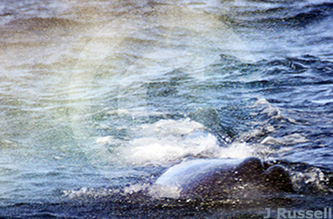
An adult male common cachalot's head is one third the length of it's body. A toothed whales brain is complex, with its spindle cells being three times more concentrated than in human brains. These are thinking, feeling, sensitive beings of imense evolutionary experience. These marine mammals are born without teeth, their teeth do not grow until sexual maturity. The cone shaped teeth can reach 28cm (11 inches) long on a full grown adult. Teeth are only on the bottom jaw, they fit into the toothless upper jaw.
Cachalot fall into the toothed whale family, so do dolphin, orca, beluga, and pilot whale. Toothed whales use their intelligence, their advanced sonar, and their teeth to catch and eat fish. Toothed whales like cachalot are different from the other great whales like blue, fin, bowhead, Southern, sei, bryde's, humpback and gray whales who are all baleen whales. Baleen whales have no teeth, and eat tiny krill. Baleen whales eat by taking huge gulps of water, and filter feed through their massive baleen plates. Baleen whales do not hunt in the same way that toothed whales do.
Cachalot are the largest toothed animal in the ocean, in fact they are the largest toothed predator on Earth.
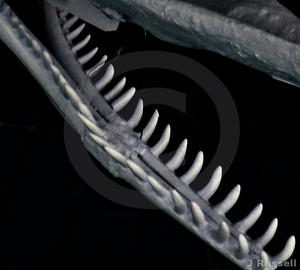
Cachalot have the ability to dive for up to 2 hours, to hunt for giant squid in the depths of the deepest oceans. An average dive lasts around 45 minutes, and it is believed that an adult whale can reach a depth of 3km, or almost two miles deep!
They have the most powerful natural sonar system in the world and they dive deeper, and longer, than any other air breathing mammal.
Studies of the skeletons of these magnificent marine mammals have revealed that cachalot, just like us humans, may be susceptible to decompression sickness. The common cachalot can dive at a speed of 180 metres (560 ft) per minute.
Cachalot make the loudest sound of any living animal on our planet, and also have the largest brain on the planet.
Starting a deep dive, through the beautiful sun rays and into the depths, in search of giant squid.
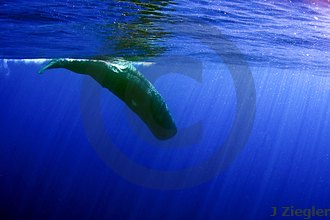
Just like humans, great apes and elephants, cachalot are tactile animals. They enjoy immensly having physical contact with their family and close friends and they use a lot of body language. Physical gestures are made, they touch each other and posture their bodies to portray their feelings, just like we do.
Over the years, lots of physical data on whales has been gathered, but until quite recently most of the studies were only on dead whales. Today we can learn from universities who are studying live whales out in the wild, listening to codas (used as language by whales). Studies are being carried out on the language of certain types of toothed whales, particularly wild dolphins by studying their clicks and whistles.
Studies are showing us that there is far more going on inside the minds of those big brained highly sophisticated mammals than we ever imagined - Complex communications and super senses on levels that our little brains have never even dreamed of!
They caress each other lovingly.
There is evidence to show that whales could use certain frequencies of sound to stimulate the brain into feeling calm, or to subdue prey. During many whale and dolphin expeditions, people have often expressed to me that they have felt an overpowering euphoria when in the presence of whales.
What if it is possible for whales to use this low frequency sound super sense to invoke calm on us! Maybe they remember how violent we can be and feel the need to subdue us. This type of calming tool could possibly be used by the whales to calm their prey or their calves, it's fascinating to think about. We know so little about these amazing beings, we really don't know what they are capable of, which makes learning about them all the more fascinating.
We really don't know what they are capable of!
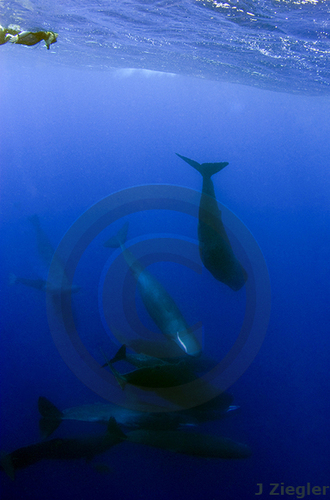
I've personally experienced being a target of sonar scans. I've felt the vibrations of fast buzzing clicks and the slow pulsing shotgun claps from cachalot, pulsing through my whole body. I've been lucky enough to see dolphins use their acoustics as sound weapons to stun fish. I've been blown away by the experience of cachalot showing me their fresh caught squid.
I am humbled by them...
After spending thousands of hours in the water with toothed whales and years studying them in their own wild ocean environment, I am honored to have learned from them. To experience the way whales use eye contact, sound, body posturing and body language to communicate is humbling. Cachalot use sound and touch to show love, desire, friendship and comfort to others. With the recent breakthroughs in knowledge on spindel cells, our knowledge of the caring and curious nature of these whales and their high level of intelligence, there is more than sufficient evidence to show that whales and dolphins (along with other higher level mammals) should have the right to live free from persecution and slavery. Individuals have different personalities, they feel pain and despair, longing to be free again back with their loved ones. They feel suffering in captivity just as much as humans do, maybe more so.
On our expeditions, as well as gathering our own data, we gather and donate id materials to other studies like The Dominica sperm whale project. These amazing studies on the family culture of whales help to protect the whales through education. I encourage you to check out the links. I also encourage you to use the information that I am providing here to educate children and adults around the world. We eventually hope to translate this information into as many languages as possible. Thank you in advance for your support in helping protect those intelligent mammals who can not speak for themselves.
December 2011, a proud cachalot shows me the squid she just caught in the depths, still wriggling in her mouth.
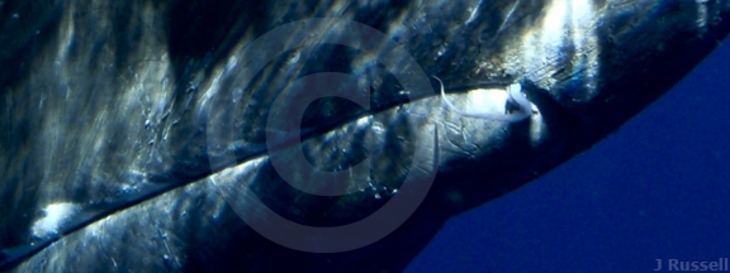
Follow our journey into the amazing world of whales
: : : : : : : : : : : RESEARCH PROJECT: COMMON CACHALOT : : : : : : : : : : :
For information on expeditions e-mail WildOceanAdventures@hotmail.com
BE AWARE: In most countries it is illegal to enter the water with marine mammals without advance government permission. We obtain a special department of fisheries research permit to carry out all of our studies. Researchers are specially trained, and have to adhere to strict guidelines, to protect the whales from stress. There is no physical interaction with the whales, no tagging or capture of any kind.
::::::::::::::::::::::::::::::::::::::::::::::::::::::::::::::::::::::::::::::::::::::::::::::::::::::::::
